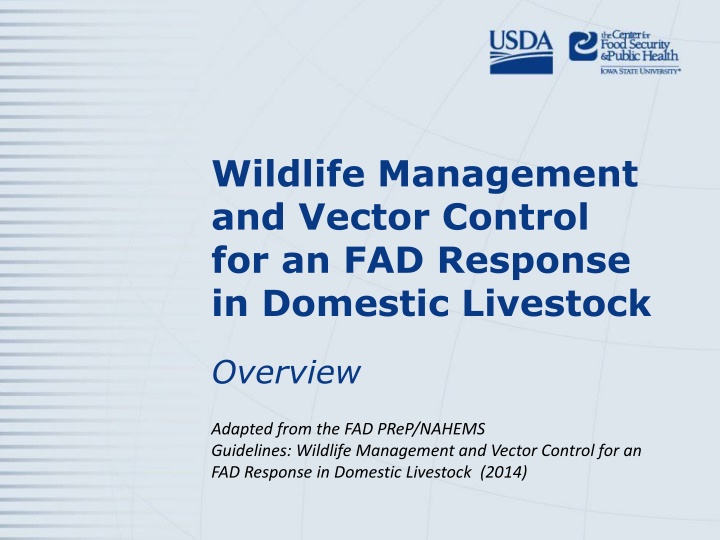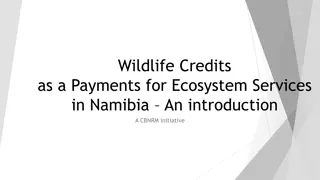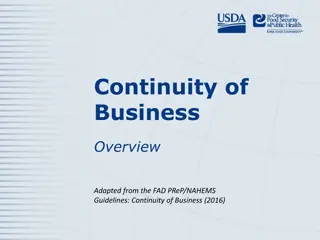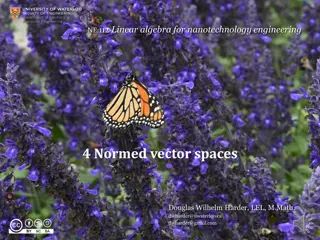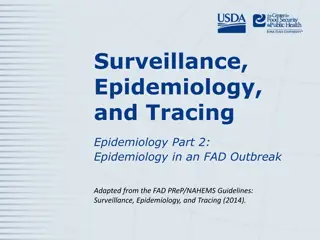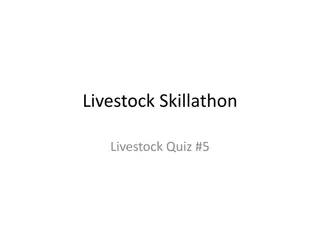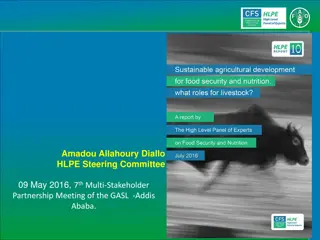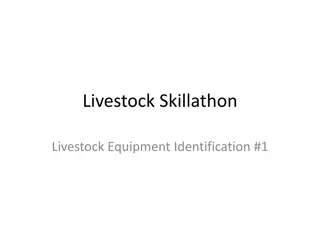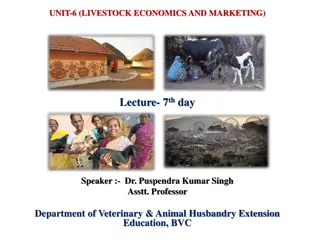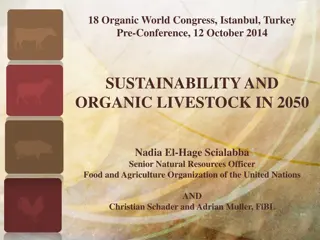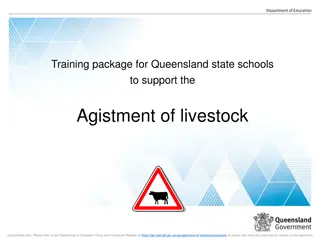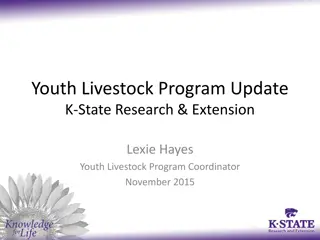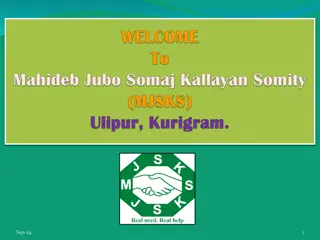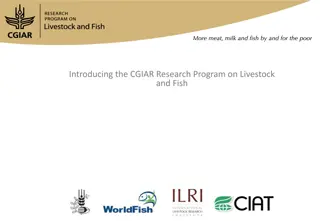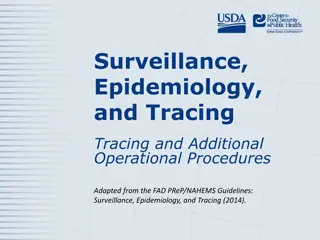Wildlife Management and Vector Control for FAD Response in Livestock
This presentation provides an overview of wildlife management and vector control strategies for responding to Foreign Animal Disease (FAD) outbreaks in domestic livestock. It covers definitions, roles and responsibilities, wildlife management methods, and collaboration between USDA APHIS and authorities regarding FADs involving wildlife.
Uploaded on Feb 15, 2025 | 11 Views
Download Presentation

Please find below an Image/Link to download the presentation.
The content on the website is provided AS IS for your information and personal use only. It may not be sold, licensed, or shared on other websites without obtaining consent from the author.If you encounter any issues during the download, it is possible that the publisher has removed the file from their server.
You are allowed to download the files provided on this website for personal or commercial use, subject to the condition that they are used lawfully. All files are the property of their respective owners.
The content on the website is provided AS IS for your information and personal use only. It may not be sold, licensed, or shared on other websites without obtaining consent from the author.
E N D
Presentation Transcript
Wildlife Management and Vector Control for an FAD Response in Domestic Livestock Overview Adapted from the FAD PReP/NAHEMS Guidelines: Wildlife Management and Vector Control for an FAD Response in Domestic Livestock (2014)
This Presentation Definitions of relevant terms APHIS Authorities Significance of wildlife in an FAD Roles and responsibilities Wildlife management methods and plans 2 FAD-PReP/NAHEMS Guidelines: Wildlife, Vector Control Overview USDA APHIS and CFSPH
Definitions - OIE Wild animal: an animal that has a phenotype unaffected by human selection and lives independent of direct human supervision or control Wildlife: all free-ranging animals, including native and exotic wildlife species, as well as feral domestic animals 3 FAD-PReP/NAHEMS Guidelines: Wildlife, Vector Control Overview USDA APHIS and CFSPH
Definitions contd Feral: domestic animals not confined Wildlife reservoir: free-ranging species as a potential source of infection/infestation Vector: any living organism that can carry disease agents Biological transmission: disease agent transfer from host to susceptible animal Mechanical transmission: disease agent transfer from host to susceptible animal via external body parts 4 FAD-PReP/NAHEMS Guidelines: Wildlife, Vector Control Overview USDA APHIS and CFSPH
Definitions contd FAD: animal disease or pest not known to exist in US or territories Emerging disease: change or mutation in pathogenicity, communicability or zoonotic potential to become a threat When livestock outbreak involves wildlife - USDA APHIS and authorities with jurisdiction over wildlife collaborate 5 FAD-PReP/NAHEMS Guidelines: Wildlife, Vector Control Overview USDA APHIS and CFSPH
USDA APHIS Authorities for Responding to an FAD Outbreak in Domestic Livestock
APHIS Authority Animal Health Protection Act (AHPA) Authorizes Secretary of Agriculture Prevent, detect, control, eradicate Title 9 of the CFR Regulations for disease control VS Memo 573.1 Animal Health Policy in Relation to Wildlife Requires collaborative relationships between agencies of authority 7 FAD-PReP/NAHEMS Guidelines: Wildlife, Vector Control Overview USDA APHIS and CFSPH
Relevance of Wildlife in an FAD Outbreak in Domestic Livestock or Poultry
Epidemiological Factors Interactions between host, agent, environment Agent: range, resistance, affinity, dose, mode of transmission Host: species, age, immune/nutritional status Environment: housing, care, weather, vector presence 9 FAD-PReP/NAHEMS Guidelines: Wildlife, Vector Control Overview USDA APHIS and CFSPH
Epidemiological Factors contd Immediately assess wildlife during an FAD Detect cases Understand disease characteristics Identify disease risks Provide information for control Evaluate effectiveness of control and adjust Ecological factors 10 FAD-PReP/NAHEMS Guidelines: Wildlife, Vector Control Overview USDA APHIS and CFSPH
International Trade Implications OIE distinguishes between wildlife infection and domestic infection for some diseases wildlife role in transmission, maintenance of agent Not all countries will follow OIE guidelines for trade 11 FAD-PReP/NAHEMS Guidelines: Wildlife, Vector Control Overview USDA APHIS and CFSPH
Roles and Responsibilities ICS, NIMS, Unified Command Wildlife Cell, Vector Control Group Protect domestic animals and wildlife All personnel have proper training Wildlife Services coordinates with other agencies SERS, NWDP Livestock owners, producers 12 FAD-PReP/NAHEMS Guidelines: Wildlife, Vector Control Overview USDA APHIS and CFSPH
Wildlife Management Methods and Plans in an FAD Outbreak in Domestic Livestock
Steps of Wildlife Management 14 FAD-PReP/NAHEMS Guidelines: Wildlife, Vector Control Overview USDA APHIS and CFSPH
Assessing Wildlife Population surveys Visual inspection Ground surveys, aerial surveys Local reports Carcasses Live animal capture Sentinels 15 FAD-PReP/NAHEMS Guidelines: Wildlife, Vector Control Overview USDA APHIS and CFSPH
Disease Surveillance Presence, spread, and/or prevalence Consider animal movement into and out of Control Area Diagnostic sampling may be necessary Live capture, observation, carcass collection Parameters should be outlined in surveillance plan 16 FAD-PReP/NAHEMS Guidelines: Wildlife, Vector Control Overview USDA APHIS and CFSPH
Contain and Control Wildlife Manipulate populations, habitat, or other factors Removal, relocation, dispersal, containment Buffer zones Monitor, surveillance for effectiveness Impacts evaluated 17 FAD-PReP/NAHEMS Guidelines: Wildlife, Vector Control Overview USDA APHIS and CFSPH
Animal and Personnel Safety Safety is a priority Trained and experienced personnel Animal safety Minimize stress on animals Personnel safety Chain of command with assigned duties Determine all animal procedures, equipment, safety plans ahead of time 18 FAD-PReP/NAHEMS Guidelines: Wildlife, Vector Control Overview USDA APHIS and CFSPH
Demonstrating Disease Freedom Reestablishing international trade Wildlife-specific surveillance plan may need to be developed Not always feasible, practical for wildlife FAD PReP/NAHEMS Guidelines: Surveillance, Epidemiology, and Tracing 19 FAD-PReP/NAHEMS Guidelines: Wildlife, Vector Control Overview USDA APHIS and CFSPH
Developing a Wildlife Management Plan
Factors to Consider Epidemiology Study distribution of disease Data, observations of animals Ecology Location, habitat, seasonal social/feeding behavior Resources Availability, personnel, equipment Socio-political Economy, law, regulation, public opinion, safety 21 FAD-PReP/NAHEMS Guidelines: Wildlife, Vector Control Overview USDA APHIS and CFSPH
Personnel, Equipment, Reporting Personnel Understand biosecurity, safety protocols Hazard exposure may include zoonosis PPE, vaccination Safety Officer safe work procedures Equipment, cleaning and disinfection Information collected, reported Manage, store, analyze, disseminate 22 FAD-PReP/NAHEMS Guidelines: Wildlife, Vector Control Overview USDA APHIS and CFSPH
Vector Control in an FAD Outbreak in Domestic Livestock
Vector-borne FADs Transmission of disease pathogen Mechanical Biological Methods of vector control Understand life cycle and relationship to host and pathogen Focus on habitat reduction, minimizing contact, chemical/biological control 24 FAD-PReP/NAHEMS Guidelines: Wildlife, Vector Control Overview USDA APHIS and CFSPH
Methods of Vector Control Habitat reduction Change vector-required conditions Minimizing contact Limit exposure to habitat or during activity Chemical control Supplemental measure Apply to vector habitat, to animal, or feed as insect growth regulators Biological control Release agents or natural predators 25 FAD-PReP/NAHEMS Guidelines: Wildlife, Vector Control Overview USDA APHIS and CFSPH
Response Activities Movement control Adhere to Incident Command restrictions on movement and quarantine Biosecurity Prevent spread of disease on personnel, vehicles, equipment, etc. C&D Euthanasia Must be treated humanely at all times Follow disposal protocols Communication Public Information Officer will address public issues on outbreak 27 FAD-PReP/NAHEMS Guidelines: Wildlife, Vector Control Overview USDA APHIS and CFSPH
For More Information FAD PReP/NAHEMS Guidelines: Wildlife Management and Vector Control for an FAD Response in Domestic Livestock http://www.aphis.usda.gov/fadprep Wildlife Management and Vector Control web-based training module Coming soon 28 FAD-PReP/NAHEMS Guidelines: Wildlife, Vector Control Overview USDA APHIS and CFSPH
Guidelines Content Authors (CFSPH) Glenda Dvorak, DVM, MS, MPH, DACVPM Nicole Seda, BS Meghan Blankenship, BS Heather Allen, PhD, MPA Contributor (USDA) Jonathan Zack, DVM 29 FAD-PReP/NAHEMS Guidelines: Wildlife, Vector Control Overview USDA APHIS and CFSPH
Guidelines Content Reviewers (USDA) Randall Levings, DVM, MS Randall Crom, DVM Michael Messenger, PhD Michael David MS, VMD, MPH Wildlife Disease Steering Committee Subject Matter Experts Claudio L. Afonso Samantha Gibbs, DVM, PhD D. Scott McVey, DVM, PhD, DACVM David Suarez, DVM 30 FAD-PReP/NAHEMS Guidelines: Wildlife, Vector Control Overview USDA APHIS and CFSPH
Acknowledgments Development of this presentation was by the Center for Food Security and Public Health at Iowa State University through funding from the USDA APHIS Veterinary Services PPT Authors: Abbey Smith, Student Intern; Janice Mogan, DVM Reviewers: Glenda Dvorak, DVM, MPH, DACVPM; Heather Allen, PhD, MPA
